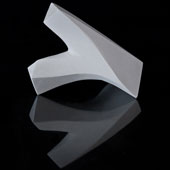Design Course
Elements of 3 Dimensional Design
Towards Design of Objects
by
Form:
Form refers to the visual and physical structure of an object. It is 3-dimensional. We live in a 3D space surrounded by stationery and kinetic forms. Human beings, like all objects, exist in a form-space relationship. Form and space are complimentary and one cannot exist without the other. Space is an aid to the perception and appreciation of form.
Form – Movement and Forces:
The nature of the 3D experience of form is rooted in the perception of the energy and inner structure of form or composition.
In the generation and analysis of the 3-D composition, one must perceive the inner- and spatial activity of the visual elements. These activities encompass the combined effect of the movement of an axis and the forces that act upon it. This visual energy is seen to interact with the proportions and shapes of the elemental parts of the form. These are indirectly perceived through visual clues from the positive form.
The interplay of the surface/plane governs the movement of form. The transition between surfaces in turn controls the position, shape and sharpness of edges as surfaces come together in form. The corners and points add visual detail to the form.
Assignment 2:
Selecting two / three sub-forms to develop a strategy for visualization and development of form to communicate:
• Movement and forces
• Hierarchy and visual order
• Twist and bend
Develop design proposals for the same in 3-dimension.
• Material:
PoP/ Wood/ Wire or any other material as found appropriate for the design concept.
• Keywords:
Form and Communication; Movement and Forces; Hierarchy and Order; Twist and Bend; Visual Perception.
• Approach:
To understand the personality of the different geometric forms - their hierarchy and order; spatial movement patterns; transformations; their character.
Twist:
Twist and Bend:









